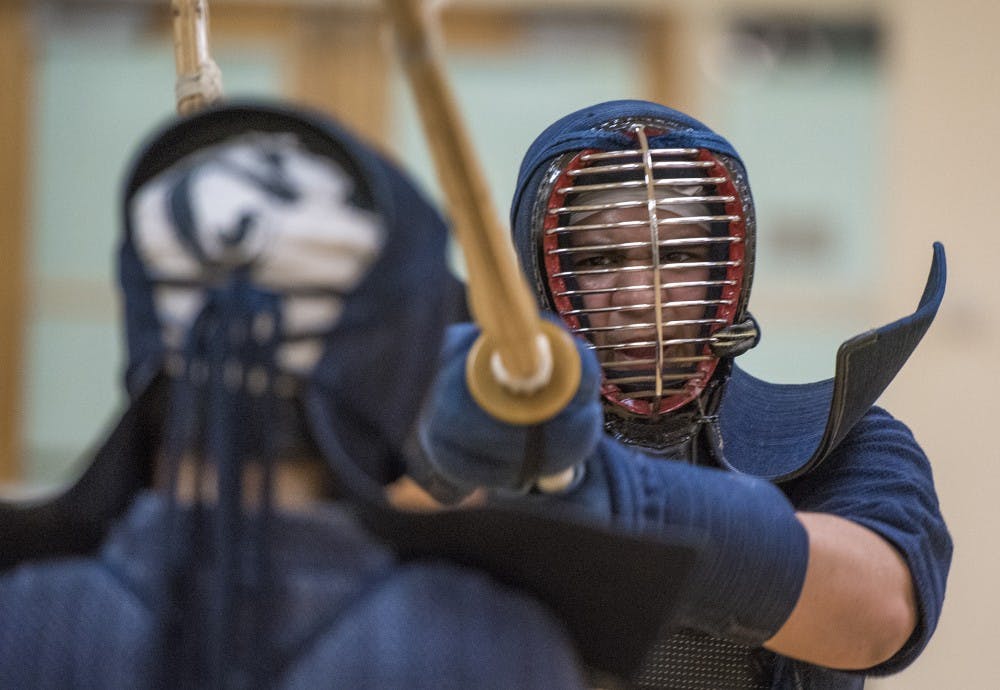Jay Ryu has been a dedicated kendo practitioner for 36 years.
Ryu, professor of public policy and administration, picked it up as a senior in high school after asking his physical education teacher what kind of martial art he could do to get stronger. He was small and weak, he said, and worried about being bullied by his peers. Kendo, or the Japanese “way of the sword,” clicked with him.
The origins of kendo can be traced back to samurai training practices. The martial art involves wearing traditional Japanese clothing and armor while attacking an opponent with a bamboo sword.
Ryu said practicing kendo did make him stronger physically, but more importantly, it has improved his mental strength, which is what has inspired him to continue his practice for so many years.
“As I continue kendo, obviously I’ve achieved some strength in my muscle. But more importantly, I found that kendo has gave me the warrior mindset,” he said. “Like a strength in my soul.”
When he came to Ohio University in 2003, Ryu searched the area for somewhere to practice and teach kendo to others. When he was unable to find one, he decided to make his own. In 2004, he formed the OU Kendo Club. He has served as both the faculty adviser and club sensei ever since.
The club currently has about 10 active members. Group members practice in Ping Center twice a week, honing their skills and preparing for occasional joint practices and competitions with other nearby universities.
Ryu said the biggest challenge when teaching kendo to beginners is explaining the importance of skill over strength. Correct technique is much more important than the force behind the hit. And once the skill is learned, it’s all about mind control.
Despite those difficulties, Ryu said the mental toughness that develops through kendo is the most rewarding part of the sport. He said through his practice, his productivity in academics and research has drastically improved.
“The nature of kendo is if you’re not concentrating on the tip of your sword, you get hit,” he said. “This is the best beauty of kendo: concentration power.”
Addy Kruse, a junior studying chemistry, took over as president of the OU Kendo Club in 2017 after being in the club since her freshman year. She has practiced martial arts since she was a child, but kendo was new to her when she came to college.
“It’s not like any other club you would want to join,” she said. “If you’re looking for something really unique that you’ve never done before, kendo’s it.”
Kruse said kendo differs from most other martial arts because of the use of the sword, called the shinai. It is made of four slats of bamboo tied together, and when used correctly, won’t hurt an opponent. She said she always wanted to try sword fighting, and it was one of the things that initially attracted her to the club.
The biggest challenge of kendo, Kruse said, is how unnatural it is. The movements and armor are nothing like what one would encounter on a day-to-day basis, and it’s all a lot to get used to. But even when it’s most difficult, she can rely on her fellow club members to keep her motivated.
“I really like the camaraderie with Kendo Club,” she said. “That’s what makes a lot of people stay, I think, even when it gets really tough. … You still have a lot of other people who are doing the same thing, which is pretty cool.”
Alex Airado, vice president of the Kendo Club, joined the the club his freshman year as well. Since then, he’s carefully honed his skills and has placed among the top competitors at nearby tournaments.
Unlike many of his fellow club members, Airado, a senior studying criminology, lives for the competitive aspect. But honing his technique to succeed has been a bit of a challenge.
“I guess the hardest part would actually be the skill or technique acquisition,” he said. “People don’t normally understand the footwork or even how to swing the sword properly without breaking it.”
Despite its challenges, kendo practice is something Airado looks forward to each week. He plans to continue practicing the art even after college.
“This is a lifetime sport,” he said. “It kind of teaches you how to be as a person, really.”






